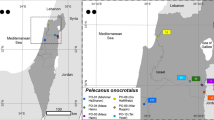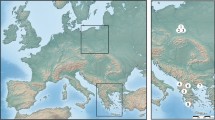Abstract
Seven isolates of Cryptocaryon irritans from different host species and geographical locations in Mainland China were characterized by the first (ITS-1) and second (ITS-2) internal transcribed spacers (ITS) of nuclear ribosomal DNA (rDNA) using two isolates of Ichthyophthirius multifiliis for comparative purposes. The rDNA region including the ITS-1, 5.8S, ITS-2, and flanking 18S and 28S sequences were amplified by polymerase chain reaction and the amplicons were sequenced directly. The ITS-1, 5.8S, and ITS-2 sequences were 129, 160, and 190 bp in length, respectively, for all seven C. irritans isolates, whereas the corresponding sequences for the two I. multifiliis isolates were 142, 153, and 194 bp, respectively. While sequence variation among the seven C. irritans isolates ranged from 0 to 1.6% in both the ITS-1 and ITS-2, and the two I. multifiliis isolates differed by 1.4% in the ITS-1 and 1.0% in the ITS-2; C. irritans differed from I. multifiliis by 57.1–60.9% in the ITS-1 and 79.4–83.0% in the ITS-2, indicating that ITS sequences provide reliable genetic markers for the identification and differentiation of the two species. Phylogenetic analysis using the sequence pairwise-distance data using the neighbor-joining method inferred that the seven C. irritans isolates from Mainland China and two other isolates (T.A and Aus.C) from other countries clustered together to show monophyly, which could be readily distinguished from the other monophyletic group all from other regions. Therefore, ITS sequence data and phylogenetic analysis provided strong support that C. irritans isolates from Mainland China represent a single species. The definition of genetic markers in the ITS rDNA provide opportunities for studying the ecology and population genetic structures of the C. irritans from Mainland China and elsewhere and is also relevant to the diagnosis and control of fish diseases they cause.




Similar content being viewed by others
References
Andree KB, E1-Matbouli M, Hoffman RW, Hedrick RP (1999) Comparison of 18S and ITS-1 rDNA sequences of selected geographic isolates of Myxobolus cerebralis. Int J Parasitol 29:771–775
Burgess PJ, Matthews RA (1995) Fish host range of seven isolates of Cryptocaryon irritans (Ciliophora). J Fish Biol 46:727–729
Colenman AW (2005) Paramecium aurelia revisited. J Eukaryot Microbiol 52:68–77
Colorni A (1985) Aspects of the biology of Cryptocaryon irritans and hyposalinity as a control measure in cultured gilt-head sea bream Sparus aurata. Dis Aquat Org 1:19–22
Colorni A (1987) Biology of Cryptocaryon irritans and strategies for its control. Aquaculture 67:236–237
Colorni A, Burgess P (1997) Cryptocaryon irritans Brown 1951, the cause of ‘white spot disease’ in marine fish: an update. Aquar Sci Conserv 1:217–238
Diggles BK (1997) Some information on the morphology of Cryptocaryon irritans from South-East Queensland, Australia. Eur J Protistol 33:200–210
Diggles BK, Adlard RD (1997) Intraspecific variation in Cryptocaryon irritans. J Eukaryot Microbiol 44:25–32
Diggles BK, Lester RJG (1996a) Infections of Cryptocaryon irritans on wild fish from southeast Queensland, Australia. Dis Aquat Org 25:159–167
Diggles BK, Lester RJG (1996b) Influence of temperature and host species on the development of Cryptocaryon irritans. J Parasitol 82:45–51
Diggles BK, Lester RJG (1996c) Variation in the development of two isolates of Cryptocaryon irritans. J Parasitol 82:384–388
Elbadri GAA, De Ley P, Waeyenberge L, Vierstraete A, Moens M, Vanfleteren J (2002) Intraspecific variation in Radopholus similes isolates assessed with restriction fragment length polymorphism and DNA sequencing of the internal transcribed spacer region of the ribosomal RNA cistron. Int J Parasitol 32:199–220
Engberg J, Nielsen H (1990) Complete sequence of the extrachromosomal rDNA molecule from the ciliate Tetrahymena thermophila strain B1868VII. Nucleic Acids Res 18:6915–6919
Gasser RB, Chilton NB, Hoste H, Beveridge I (1993) Rapid sequencing of rDNA from single worms and eggs of parasitic helminths. Nucleic Acids Res 21:2525–2526
Huang WY, He B, Wang CR, Zhu XQ (2004) Characterisation of Fasciola species from Mainland China by ITS-2 ribosomal DNA sequence. Vet Parasitol 120:75–83
Jee BY, Kim KH, Park SH, Kim YCh (2000) A new strain of Cryptocaryon irritans from the cultured olive flounder Paralichthys olivaceus. Dis Aquat Org 43:211–215
Kumar S, Tamura K, Nei M (2004) MEGA3: integrated software for molecular evolutionary genetics analysis and sequence alignment. Brief Bioinform 5:150–163
Li AX, Amello SD, Paggl L, He F, Gasser RB, Lun ZR, Abollo E, Turchetto M, Zhu XQ (2005) Genetic evidence for the existence of sibling species within Contracaecum rudolphii Hartwich, 1964 and the validity of Contracaecum septentrionale Kreis, 1955 (Nematoda: Anisakidae). Parasitol Res 96:361–366
Meinilä M, Kuusela J, Ziêtara MS, Lumme J (2004) Initial steps of speciation by geographic isolation and host switch in salmonid pathogen Gyrodactylus salaries (Monogenea: Gyrodactylidae). Int J Parasitol 34:515–526
Price DJ, Clayton GM (1999) Genotype–environment interactions in the susceptibility of the common carp, Cyprinus carpio, to Ichthyophthirius multifiliis infections. Aquaculture 173:149–160
Thompson JD, Gibson TJ, Plewniak F, Jeanmougin F, Higgins DG (1997) The Clustal-X windows interface: flexible strategies for multiple sequence alignment aided by quality analysis tools. Nucleic Acids Res 24:4876–4882
Wright ADG, Colorni A (2002) Taxonomic re-assignment of Cryptocaryon irritans, a fish parasite. Eur J Protistol 37:375–378
Wu XY, Chilton NB, Zhu XQ, **e MQ, Li AX (2005) Molecular and morphological evidence indicates that Pseudorhabdosynochus lantauensis (Monogenea: Diplectanidae) represents two species. Parasitology 130:669–677
Xu RL, Bai QS, GS Li, Jiang JB (1995a) Ultrastructural study on tomite of Cryptocaryon irritans Brown, 1951. J Sun Yat-Sen Univ Suppl 1:142–145 (in Chinese with abstract in English)
Xu RL, Bai QS, GS Li, Jiang JB (1995b) The host visceral histochemical changes caused by “white spot” disease in marine fishes. J Sun Yat-Sen Univ Suppl 1:146–148 (in Chinese with abstract in English)
Yambot AV, Song YL, Sung HH (2003) Characterization of Cryptocaryon irritans, a parasite isolated from marine fishes in Taiwan. Dis Aquat Org 54:147–156
Zhu XQ, Gasser RB, Podolska M, Chilton NB (1998) Characterisation of anisakid nematodes with zoonotic potential by nuclear ribosomal DNA sequences. Int J Parasitol 28:1911–1921
Zhu XQ, Chilton NB, Jacobs DE, Boes J, Gasser RB (1999) Characterisation of ascaris from human and pig hosts by nuclear ribosomal DNA sequences. Int J Parasitol 29:469–478
Zhu XQ, D’Amelio S, Paggi L, Gasser RB (2000) Assessing sequence variation in the internal transcribed spacers of ribosomal DNA within and among members of the Contracaecum osculatum complex (Nematoda: Ascaridoidea: Anisakidae). Parasitol Res 86:677–683
Zhu XQ, D’Amelio S, Hu M, Paggi L, Gasser RB (2001) Characterisation of anisakid nematodes with zoonotic potential by nuclear ribosomal DNA sequences Electrophoretic detection of population variation within Contracaecum ogmorhini (Nematoda: Ascaridoidea: Anisakidae). Electrophoresis 22:1930–1934
Zhu XQ, D’Amelio S, Palm HW, Paggi L, George-Nascimento M, Gasser RB (2002) SSCP-based identification of members within the Pseudoterranova decipiens complex (Nematoda: Ascaridoidea: Anisakidae) using genetic markers in the internal transcribed spacers of ribosomal DNA. Parasitology 124:615–623
Acknowledgements
This project was supported and provided, in part, by grants from the National Natural Science Foundation of China (grant no. 30440052), the Natural Science Foundation of Guangdong Province (grant nos. 20031640 and 20023002), the Scientific and Technological Programmes of Zhuhai City (grant no. 200411022) to AXL, and from the China National Science Funds for Distinguished Young Scientists (grant no. 30225033) to XQZ. The experiments comply with the current laws of the countries in which the experiments were performed.
Author information
Authors and Affiliations
Corresponding author
Rights and permissions
About this article
Cite this article
Sun, H.Y., Zhu, X.Q., **e, M.Q. et al. Characterization of Cryptocaryon irritans isolates from marine fishes in Mainland China by ITS ribosomal DNA sequences. Parasitol Res 99, 160–166 (2006). https://doi.org/10.1007/s00436-006-0151-x
Received:
Accepted:
Published:
Issue Date:
DOI: https://doi.org/10.1007/s00436-006-0151-x




